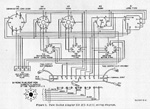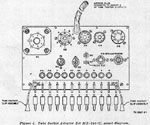Ebay prices 2007: Very good one. 200$ |
Hickock I-177 This was my first tube tester. I have two of those. I bought the first one 15 years ago for 25 Euro in the same old electronics shop, where I bought my stuff when I was a kid. (Radio Kwakkelstein in Vlaardingen). Many years later he had a second one, that was broken and he still wanted 45 Euro for it. I took it for spare parts, but never needed any. The thing was made to last for ever, and work without maintenance in the humid and warm countries where the US army is going to save the world. So even if you find a stinky old one, it might be good still. It tests all tubes from before the Noval tubes. For later tubes there is an adapter kit, which by itself is a very valuable thing too, and this kit can be used on any other tester. I-177 is a really fantastic tester, it gives remarkable reliable results on the good/bad scale. They all need a calibration badly, if never done before. If this tester says the tube is "just ok" you can bet it that is just what it is. Most of all you get used to the reading when you test the same kind of tubes, and if you see a tube which is into as good as the other, you better throw that tube away. ( or sell it on Ebay (ahem....) Basically this is THE Hickock tester for the pre-noval tubes. The later model was the TV7 , which could do also test Noval tubes. The I-177 has an interesting way it operates, and this is worth a few lines here. They use their famous patented Hickok circuit, but in the I-177 they added a potentiometer which does noting else then change the meter sensitivity. The signal going to the meter has to pass an attenuator potentiometer. This is the "L" potentiometer. The result of that is, you can test any tube at all, and have a correct reading on the good/bad scale when you know the setting of that attenuator potentiometer. (Of course they knew that at Hickok, and this is the "L" value in the handbook). Since the good/bad readings are done by measuring true, dynamic Gm, there is also this particular position of that potentiometer where the Gm (micro mho) scale is valid. This position is marked with "gm" on the L Pot scale. So the good/bad reading and micro mho reading is done with the same circuit. Their patented Gm measuring circuit is the best of it's kind as far as I know. Due to this patent all other manufacturers had to work without it. It tests all known rectifiers. Also the big triodes like 300B can be tested, and as we know there are not many tube testers that can handle this tube. Not even all later model Hickoks can do a 300B. By experimenting with the settings I can now measure many unlisted tubes with it, like C3g and EM34. It's really a very nice tester, very much recommended. The circuit diagram is inside the tester on a plastic plate. (Fungus proof....), and an Excel list with all test data I found in the internet. These will all work in 100 years from now. They used to be cheap, and regardless useless. Some start to understand how good they are, and prices of those went up a lot over the last years. The bargain days are over, a good tube tester is expensive no matter what. I think these are still a good buy for the money. Here is how to find out settings for an large size tube, like KT88 or so.
Here are some settings I found that way: KT88 A=8 B=5 Fil=6.3 L=70 R=42, Socket E, Gm switch at 6000. ECC88/6822, use MX949 adpater kit. Only good/bad testing possible. This setting will tests new tubes in the middle of the green scale: A=4 B=2 Fil=6.3 L=50 R=20. Gm switch at 6000. Triode #1 setting 1=P 2=G 3=K 4=Fil 5=Fil. Triode #1 P=6 G=7 K=8. I have only verified it with one strong NOS tube. Please let me know if you find completely different settings. The "R" pot value I would keep that value. You can correct the "L" pot, until you tester reads new ECC88 in the middle of the green scale. With my tester that was at L=50. In a few words: The best of this tester is the good/bad test. It discovers any potentially weak tube. Good buy when you use pre-war tubes. It can give the real Gm value of the tubes, and good/bad indication. It has no sockets for modern tubes. Use the MX949 adapter kit, and you can test any modern tube also. Make sure when you buy the adapter kit, you have the extended manual with it, otherwise you only have the adapter kit, but not the settings for it. They are all extremely out of calibration, so that needs to be done for 100% sure, unless the seller did it already for you. Steve Nolan has the complete manual as Excel file in the internet. (just Google for it) |



